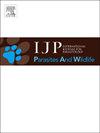吐鲁番-哈密盆地白蝇(绵虫纲:刺虫科)寄生副刺虫新种
IF 2
3区 医学
Q3 ECOLOGY
International Journal for Parasitology-Parasites and Wildlife
Pub Date : 2025-06-23
DOI:10.1016/j.ijppaw.2025.101107
引用次数: 0
摘要
摘要在吐鲁汉盆地发现了一种新的线虫,Parapharyngodon stoliczkana sp. nov.(线虫纲:咽线虫科),这是对该寄主肠道蠕虫的首次记录。通过形态学(光镜和扫描电镜)和分子(18S、28S rRNA和COI基因)相结合的综合分类方法对标本进行分析。雄性有4个唇状乳头,3对尾状乳头,1个针状突起(67.16 ~ 77.82 μm)和侧瓣。雌性有6个唇状乳头,卵(150-156 × 37-39 μm),卵巢后球。系统发育分析(18S + 28S + COI)表明,P. stoliczkana sp. 11 .是P. echinatus + P. micipsae的姐妹系(BPP = 1, BS = 99),遗传差异超过种间阈值(COI p-distance: 36.34 ~ 49.53%)。感染率100%(8只宿主),平均感染强度360.1±41.2只/宿主。在形态上,该物种在尾端乳头状突起、针尖长度和卵巢位置上不同于同类物种。本研究解决了副咽齿龙在分类上的歧义,提供了诊断关键,并为今后在干旱生态系统中爬行动物-寄生虫共同进化的研究建立了基础分子数据。本文章由计算机程序翻译,如有差异,请以英文原文为准。

New species of Parapharyngodon (Nematoda: Pharyngodonidae) parasite of Laudakia stoliczkana (Lacertilia: Agamidae) from Turpan-Hami Basin, China
A new nematode species, Parapharyngodon stoliczkana sp. nov. (Nematoda: Pharyngodonidae), is described from the cecum of Laudakia stoliczkana (Agamidae) in China's Turpan-Hami Basin, marking the first documentation of intestinal helminths in this host. Specimens were analyzed via integrative taxonomy, combining morphological (light and scanning electron microscopy) and molecular approaches (18S, 28S rRNA and COI genes). Males exhibited four labial papillae, three pairs of caudal papillae, a single spicule (67.16–77.82 μm), and lateral alae. Females possessed six labial papillae, operculated eggs (150–156 × 37–39 μm), and post-bulbar ovaries. Phylogenetic analyses of concatenated sequences (18S + 28S + COI) placed P. stoliczkana sp. nov. as a sister lineage to P. echinatus + P. micipsae (BPP = 1, BS = 99), with genetic divergences exceeding interspecific thresholds (COI p-distance: 36.34–49.53 %). Infection prevalence was 100 % (8 hosts), mean intensity 360.1 ± 41.2 helminths/host. Morphologically, the species differs from congeners in caudal papillation, spicule length, and ovarian positioning. This study resolves taxonomic ambiguities in Parapharyngodon, provides diagnostic keys, and establishes foundational molecular data for future studies on reptile-parasite coevolution in arid ecosystems.
求助全文
通过发布文献求助,成功后即可免费获取论文全文。
去求助
来源期刊

International Journal for Parasitology-Parasites and Wildlife
Medicine-Infectious Diseases
CiteScore
3.80
自引率
5.60%
发文量
113
审稿时长
45 days
期刊介绍:
The International Journal for Parasitology: Parasites and Wildlife (IJP-PAW) publishes the results of original research on parasites of all wildlife, invertebrate and vertebrate. This includes free-ranging, wild populations, as well as captive wildlife, semi-domesticated species (e.g. reindeer) and farmed populations of recently domesticated or wild-captured species (e.g. cultured fishes). Articles on all aspects of wildlife parasitology are welcomed including taxonomy, biodiversity and distribution, ecology and epidemiology, population biology and host-parasite relationships. The impact of parasites on the health and conservation of wildlife is seen as an important area covered by the journal especially the potential role of environmental factors, for example climate. Also important to the journal is ''one health'' and the nature of interactions between wildlife, people and domestic animals, including disease emergence and zoonoses.
 求助内容:
求助内容: 应助结果提醒方式:
应助结果提醒方式:


